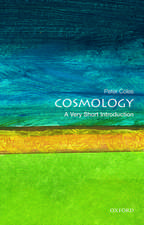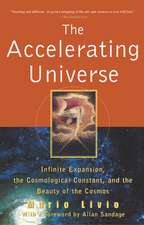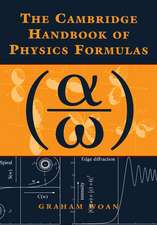Introduction to Celestial Mechanics: Astrophysics and Space Science Library, cartea 7
Autor Jean Kovalevskyen Limba Engleză Paperback – 3 apr 2012
Din seria Astrophysics and Space Science Library
- 24%
 Preț: 799.10 lei
Preț: 799.10 lei - 15%
 Preț: 647.92 lei
Preț: 647.92 lei - 18%
 Preț: 983.81 lei
Preț: 983.81 lei - 18%
 Preț: 790.28 lei
Preț: 790.28 lei -
 Preț: 359.86 lei
Preț: 359.86 lei -
 Preț: 389.71 lei
Preț: 389.71 lei - 20%
 Preț: 691.14 lei
Preț: 691.14 lei - 20%
 Preț: 816.18 lei
Preț: 816.18 lei - 18%
 Preț: 1011.27 lei
Preț: 1011.27 lei -
 Preț: 402.56 lei
Preț: 402.56 lei - 15%
 Preț: 664.93 lei
Preț: 664.93 lei -
 Preț: 398.15 lei
Preț: 398.15 lei - 18%
 Preț: 954.77 lei
Preț: 954.77 lei -
 Preț: 411.04 lei
Preț: 411.04 lei - 18%
 Preț: 1225.31 lei
Preț: 1225.31 lei - 18%
 Preț: 1843.29 lei
Preț: 1843.29 lei -
 Preț: 393.13 lei
Preț: 393.13 lei -
 Preț: 400.26 lei
Preț: 400.26 lei - 18%
 Preț: 953.82 lei
Preț: 953.82 lei - 18%
 Preț: 960.61 lei
Preț: 960.61 lei -
 Preț: 398.35 lei
Preț: 398.35 lei -
 Preț: 390.84 lei
Preț: 390.84 lei -
 Preț: 413.76 lei
Preț: 413.76 lei -
 Preț: 416.64 lei
Preț: 416.64 lei - 18%
 Preț: 947.67 lei
Preț: 947.67 lei -
 Preț: 404.51 lei
Preț: 404.51 lei - 18%
 Preț: 956.50 lei
Preț: 956.50 lei -
 Preț: 403.75 lei
Preț: 403.75 lei - 18%
 Preț: 1229.40 lei
Preț: 1229.40 lei - 18%
 Preț: 1224.99 lei
Preț: 1224.99 lei -
 Preț: 404.29 lei
Preț: 404.29 lei - 15%
 Preț: 654.77 lei
Preț: 654.77 lei - 18%
 Preț: 1248.20 lei
Preț: 1248.20 lei - 18%
 Preț: 955.25 lei
Preț: 955.25 lei - 18%
 Preț: 1846.28 lei
Preț: 1846.28 lei - 18%
 Preț: 1233.06 lei
Preț: 1233.06 lei - 18%
 Preț: 1234.77 lei
Preț: 1234.77 lei
Preț: 380.45 lei
Nou
Puncte Express: 571
Preț estimativ în valută:
72.81€ • 79.06$ • 61.16£
72.81€ • 79.06$ • 61.16£
Carte tipărită la comandă
Livrare economică 23 aprilie-07 mai
Preluare comenzi: 021 569.72.76
Specificații
ISBN-13: 9789401175500
ISBN-10: 9401175500
Pagini: 140
Ilustrații: VIII, 134 p.
Dimensiuni: 170 x 244 x 7 mm
Greutate: 0.24 kg
Ediția:Softcover reprint of the original 1st ed. 1967
Editura: SPRINGER NETHERLANDS
Colecția Springer
Seria Astrophysics and Space Science Library
Locul publicării:Dordrecht, Netherlands
ISBN-10: 9401175500
Pagini: 140
Ilustrații: VIII, 134 p.
Dimensiuni: 170 x 244 x 7 mm
Greutate: 0.24 kg
Ediția:Softcover reprint of the original 1st ed. 1967
Editura: SPRINGER NETHERLANDS
Colecția Springer
Seria Astrophysics and Space Science Library
Locul publicării:Dordrecht, Netherlands
Public țintă
ResearchCuprins
I / The Principles of Celestial Mechanics.- 1. The Fundamental Law of General Mechanics.- 2. General Theorems of Mechanics.- 3. Newton’s Law.- 4. The Scope and Limitations of Newton’s Law.- 5. The TV-Body Problem.- 6. Equations of the N-Body Problem.- 7. Integrals of the N-Body Problem.- II / The Two-Body Problem.- 8. The Importance of the Two-Body Problem.- 9. Absolute and Relative Motion of Two Bodies.- 10. Form of the Trajectories.- 11. Kepler’s Law.- 12. Study of Elliptical Motion.- 13. The Orbital Elements.- 14. Cartesian Coordinates of the Body.- 15. Astronomical Units in the Solar System.- III / Systems of Canonical Equations.- 16. TV-Body Problem Equations in a Relative Frame of Reference.- 17. Reductions of the Equations for a Three-Body Problem.- 18. The Case in which One of the Bodies has Negligible Mass.- 19. Canonical Form of the Equations.- 20. The Case in which F is not a Function of t.- 21. Integral of a System of Canonical Equations.- 22. Canonical Transformations of Variables.- 23. Examples of Canonical Transformations.- 24. Jacobi’s Theorem.- 25. Canonical Equations for the Two-Body Problem.- 26. Application of Jacobi’s Theorem to the Two-Body Problem.- 27. Meaning of the Constants a.- 28. Variables Conjugate to the Qi.- 29. Application of these Results to the General Problem.- 30. The Delaunay Variables.- 31. Osculating Elements.- 32. Lagrange Equations.- 33. The Case of Zero Eccentricity or Zero Inclination.- IV / Perturbation Theory.- 34. Introduction.- 35. Fourier Series.- 36. Expansion of the Eccentric Anomaly in Fourier Series.- 37. Definition of Bessel Functions.- 38. Some Properties of Bessel Functions.- 39. Expansion of cos jE and sin jE.- 40. Expression of Other Functions of the Two-Body Problem.- 41. Relation between E and v.- 42.D’Alembert’s Property.- 43. Limited Expansions in e.- 44. Convergence of Series Expanded in Powers of e.- 45. Expression of the Disturbing Function (the Case of the Moon).- 46. Reduction to the Variables of Elliptical Motion.- 47. Expansion of the Disturbing Function.- 48. Expansion in a Small Parameter.- 49. Theorems of Proof.- 50. Form of Equations with the Osculating Elements.- 51. Method of Solution.- 52. Long-Period and Short-Period Terms.- 53. Convergence of the Series of the Solution.- V / The Motion of an Artificial Satellite.- 54. The Potential of a Rigid Body.- 55. Expansion of the Potential.- 56. The Case of a Nearly Spherical Body.- 57. Equations of Motion of an Artificial Satellite.- 58. The Principle of Von Zeipel’s Method.- 59. Setting Up of the Equations.- 60. Elimination of the Mean Anomaly.- 61. Explicit Expression for S1.- 62. Calculation of ?’2.- 63. Elimination of g.- 64. Main Results: the Motion of Artificial Satellites.- 65. Application of the Lagrange Equations; First Approximation.- 66. Second Approximation with the Lagrange Equations.- 67. Comparison of the Two Methods.- 68. The Case of Very Small Eccentricity and Inclination.- 69. Critical Inclination.- 70. Libration of the Perigee near the Critical Inclination.- 71. The Phenomenon of Libration.- VI / Lunar Theory and the Motion of the Satellites.- 72. The Principal Problem of the Lunar Theory.- 73. Approximate Solution of the Main Problem.- 74. The Principal Inequalities of the Motion of the Moon.- 75. Various Lunar Theories.- 76. Delaunay’s Theory.- 77. The Theory of Hill and Brown.- 78. Hansen’s Theory.- 79. Improvement of the Theories.- 80. Problems of the Motion of Other Natural Satellites.- VII / The Planetary Theory.- 81. The Disturbing Function.- 82. First-OrderSolution.- 83. Expansion of the Disturbing Function by Harmonic Analysis.- 84. Other Numerical Expansions.- 85. Perturbations by Forces in Rectangular Coordinates.- 86. Variables in Hansen’s Method.- 87. Calculation by Hansen’s Method.- 88. Higher-Order Planetary Theories.- 89. Purely Numerical Methods.- 90. The Form of Numerical Integration.- 91. Starting the Numerical Integration.- 92. The Numerical Integration Proper.- 93. Properties of Numerical Integration.- 94. The Use of Numerical Integration.- 95. Comparison between Numerical Integration and Analytical Theories.
















